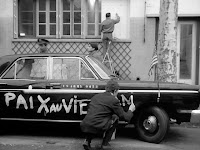 Pushing daisies is usually the euphemism used to describe someone who is dead. However, “Pushing Daisies” is not dead, it is budding with life.
Pushing daisies is usually the euphemism used to describe someone who is dead. However, “Pushing Daisies” is not dead, it is budding with life.
Refreshing is barely the best word to describe “Pushing Daisies.” As I said before, “Pushing Daisies” is budding with life, creativity, and a ton of imagination to go around. It is one of the finest TV shows made in years.
“Pushing Daisies” can claim to be a part of many genres. It is mainly a comedy filled with murder mysteries, suspense, and moving romance. It’s a classic Hollywood film wrapped into hour-long installments.
“Pushing Daisies” is centered around the life of Ned (Lee Pace). As a child, he realized he had an extraordinary gift-he could bring dead things back to life. The rules are simple: touch a dead thing once; life. Touch it again; death. Keep a dead thing alive for more than a minute, then something else in proximity has to die. Ned realizes this after reviving his dog, and his mother, only to tragically bring her back to death.
Despite this strange gift, years later, Ned is just an ordinary guy. Holding onto the last memory of his mother, Ned opens a pie restaurant to show off his other hidden talent: pie making. From time to time, Ned aides a private investigator Emerson Cod (Chi McBride) in solving murdering mysteries by bringing victims back to life. One such case involves Ned’s childhood sweatheart, Charlotte “Chuck” Charles (Anna Friel). Deciding he loves her too much, Ned decides to keep her alive for more than a minute. This is much to the chagrin of Olive (Kristin Chenoweth), the pie restaurant co-worker who is absolutely smitten with Ned.
Each episode has a similar format: Normal day, murder mystery, Ned brings body back to life, Ned finds out information, the gang gets themselves trapped in an elaborate conspiracy, they solve it and life is back to normal. Many shows run dry because their premise gets tired, and by this vague description, it might sound like the premise of “Pushing Daisies” would get old after a while. It doesn’t, because each episode the mystery is brand new. Not one murder mystery is ever in any way similar to another.
One could not discuss this show without the word “imagination” constantly popping up. That’s for a good reason. It’s because “Pushing Daisies” has an imagination that most shows today lack. The kind of willingness to put anything on the screen and see what works. In the end, it pretty much all works.
Each episodes is directed like a Tim Burton movie, especially “Edward Scissorhands.” Like a Burton movie, each screen is filled with vividly bright colors serving as an obvious contrast to what should be a very dark mood with even darker themes. In this case, the vivid colors are the bright, yellow daisies stretching in the fields farther than the eye can see.
Each mystery plot is brilliant and could even deserve their own, feature-length films. Like in a “Simpsons” episode, each plot begins very small. Suddenly, one event effects another and a chain of dominos fall to lead to some sort of conspiracy or some sort of all-too-obvious end. Many times, the surprise lies in the fact that the perpetrator seems so obvious that we feel stupid for not predicting it. Other times, more than one person seems guilty and it is almost impossible to guess what will happen next.
At that point, the plot totally has you under its spell. You can no longer predict, it unfolds itself for you. It asks you to open your imagination, yet let it guide you with its own.
Among the chaotic mysteries, the show is first and foremost a comedy. The show gets it biggest laughs mainly from Chenoweth, whose stereotypically dumb blonde attitude somehow increases the likability of her character. Equally hilarious are the wise cracks of McBride.
But maybe what’s so funny all and all is the concept behind the show itself, the idea of someone being able to live the dream of bringing anything back to life, but then having to kill it again after one minute. Funnier also are the many ways Ned uses the gift to his advantage. One such instance will remind you of “E.T.”
Among the comedy and mystery, “Pushing Daisies” also contains some romance. The biggest romance is between Ned and Chuck. They live together, and though it seems like everything should be perfect, but Ned cannot touch Chuck or she will have to die again. And this time, she her death would be permanent. It is those times, seeing Ned and Chuck close together yet so isolated, then at other times figuring out how to touch without actually touching, that are among the show’s most moving moments. It can bring a tear of joy, when they can come closer together, followed by a tear of sadness when you realize they just might not be able to make their relationship work.
It is a chilling aspect of “Pushing Daisies,” to realize that since Ned can neither touch his love nor his dog, he has little solace during tragedy. It adds on to a sort of disconnect with human beings he’s had throughout his entire life.
After two seasons “Pushing Daisies” was cancelled, ending it’s run just one week ago. Many said it was the Writers’ Strike that killed it. Wrong. It was its brilliance that killed it. “Pushing Daisies” was a bright flower just too bright for anyone to understand. It has the right to go up with “Arrested Development” and “Freaks and Geeks” as another great, misunderstood classic cancelled before its time. But hopefully, it will live on forever in the coveted hall of DVD cult fame. I don’t hope it will, I know it will.
 Mad Men: A term coined in the late 1950s to describe the advertising executives of Madison Avenue. They coined it.
Mad Men: A term coined in the late 1950s to describe the advertising executives of Madison Avenue. They coined it.
 Reporting deaths is probably the hardest part of being a journalist.
Reporting deaths is probably the hardest part of being a journalist.
 Hal Ashby. That’s a name you’ve maybe never heard, but it’s one you really need to remember. He was a prominent director of the 70s who sadly died in 1988 before hitting the age of 60. Among his many great films is 1973′s “The Last Detail.”
Hal Ashby. That’s a name you’ve maybe never heard, but it’s one you really need to remember. He was a prominent director of the 70s who sadly died in 1988 before hitting the age of 60. Among his many great films is 1973′s “The Last Detail.”
 A few days ago, I wrote a review of the wonderful gem of a TV show called “Pushing Daisies.” I remarked how the show had the distinct feeling of a Tim Burton movie. Now, Burton’s first project since “Sweeney Todd” has been announced: his own version of “Alice in Wonderland.”
A few days ago, I wrote a review of the wonderful gem of a TV show called “Pushing Daisies.” I remarked how the show had the distinct feeling of a Tim Burton movie. Now, Burton’s first project since “Sweeney Todd” has been announced: his own version of “Alice in Wonderland.”
 Pushing daisies is usually the euphemism used to describe someone who is dead. However, “Pushing Daisies” is not dead, it is budding with life.
Pushing daisies is usually the euphemism used to describe someone who is dead. However, “Pushing Daisies” is not dead, it is budding with life.
 Last night, Triumph the Insult Comic Dog made his debut on “The Tonight Show” with a video of his visit to Bonnaroo. It’s not quite in line with Triumph’s visit to the Star Wars premiere and Quebec, but it was still no doubt hilarious and even somewhat risqué for the 11:35 time slot that Carson and Leno once inhabited. Keep your ears open for a joke about Scooby Doo. Here is the video (in two parts) below:
Last night, Triumph the Insult Comic Dog made his debut on “The Tonight Show” with a video of his visit to Bonnaroo. It’s not quite in line with Triumph’s visit to the Star Wars premiere and Quebec, but it was still no doubt hilarious and even somewhat risqué for the 11:35 time slot that Carson and Leno once inhabited. Keep your ears open for a joke about Scooby Doo. Here is the video (in two parts) below:
 David Lynch has a new project on his hands, and it’s one you might not expect from the man.
David Lynch has a new project on his hands, and it’s one you might not expect from the man.


